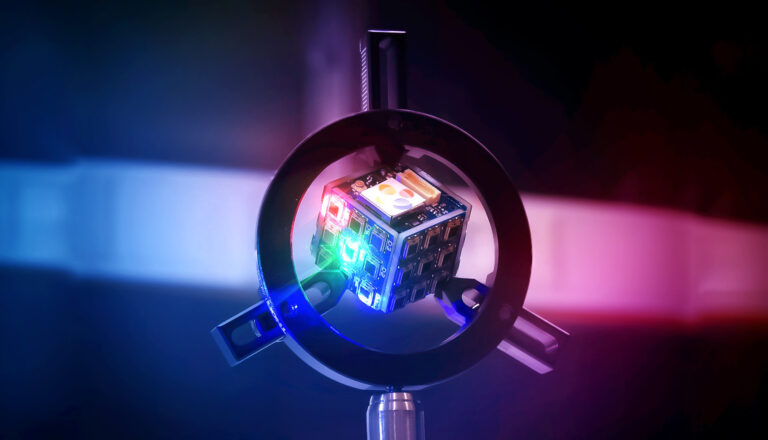Electrical Engineering
A firefly’s flash inspires new nanolaser light
Synchronized emissions from innovative on-chip lasers create possibilities for inexpensive artificial neural networks.


The complex flashing patterns of fireflies (left) led KAUST researchers to develop anapole lasers that use interactions between energy-storing nanodisks (center) to generate high-speed pulses of light on microchips (right).
Reproduced with permission from ref 1.© 2017 Gongora et al.
A reinvented, low-cost laser source that stores light energy inside nanoscale disks could underpin the development of optically powered neurocomputers, reveals a simulation study led by KAUST researchers.
Photonic devices that use controlled laser pulses to manipulate data switches, biomedical implants and solar cells are sought-after because they are lightning quick compared to traditional electronics; however, current prototypes have not been commercialized because of the difficulty in making lasers small enough to fit onto computer circuit boards, while also retaining pulse-shaping capabilities.
“The challenge of reducing an optical source down to the nanoscale is that it starts to emit energy strongly in all directions,” explains KAUST’s Andrea Fratalocchi. “This makes it almost impossible to control.”
A partnership with Yuri Kivshar’s group at the Australian National University revealed paths to beat optical diffraction limits with unconventional anapole lasers. Being made from semiconductors shaped into precisely sized nanodisks, anapoles respond to light stimulation by producing electromagnetic waves that either radiate or rotate in donut-shaped toroid distributions.
At specific excitation frequencies, interference between the two fields produces a state—the anapole—which does not emit energy in any direction and traps light inside the nanodisk.
“You can think of this laser as an energy tank—once the laser is on, it stores light and doesn’t let it go until you want to collect it,” says Fratalocchi.
To unlock the potential of this new light source, the team simulated various engineering architectures using quantum-based algorithms.
These calculations, along with improved microchip integration and thousand-fold enhancements in coupling to optical routers, predict that anapole nanolasers can generate ultrafast light pulses that are uniquely suited for studying natural patterns of signaling and neural connections.
Fratalocchi notes that the nanolasers would appear invisible to an observer until perturbed by a nearby object. Consequently, arranging the cylindrical light sources into a loop could be used to produce a chain reaction of light emissions, tunable down to as small as femtosecond pulse times.
“It’s really like a population of fireflies, where the individuals synchronize their emissions into beautiful patterns,” he explains “When we place the nanolasers close together, we can get similar control over the pulses.”
The team’s models suggest that integrating different loops of anapole nanolasers may produce oscillating, dynamic patterns useful for reproducing brain-like activities, such as machine learning and memory retrieval at low cost because the platform needs only inexpensive silicon wafers to work.
References
- Gongora, J. S. T., Miroshnichenko, A. E., Kivshar, Y. S. & Fratalocchi, A. Anapole nanolasers for mode-locking and ultrafast pulse generation. Nature Communications 8, 15535 (2017).| article
You might also like

Computer Science
Sweat-sniffing sensor could make workouts smarter

Electrical Engineering
New tech detects dehydration by touching a screen

Electrical Engineering
A new interface for efficient electronics

Electrical Engineering
Artificial neurons enable neuromorphic computing with light

Electrical Engineering
Narrow-linewidth lasers bring low-noise answer

Electrical Engineering
Octopus suckers inspire sticky medical patch

Electrical Engineering
Powering the future of the Internet of Things

Computer Science



